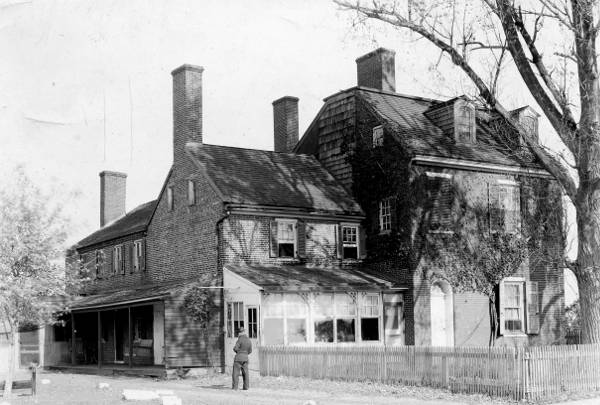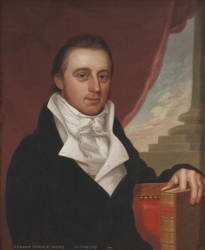Early History of the Hermitage Property
The "Hermitage", according to Wikipedia may refer to:
--A place of religious seclusion
--The Hermitage Museum of Catherine the Great in Leningrad
--The Hermitage, home and farm of President Andrew Jackson in Tenn. (1804)
--More than 70 other places called "The Hermitage", including
--The Hermitage, retreat, home of Sen. Nicholas Van Dyke Jr. (1770-1826) and farm in New Castle, Delaware
The wildflower and grass meadow, trails and the forest and marsh now on the site of the latter is the Hermitage Natural Area which is described elsewhere
 This area is named for "The Hermitage", a house dating from the 1700's
and added to by Nicholas Van Dyke Jr.
("Senator Nicholas Van Dyke") in several stages between 1801 and 1816?. According to the National Register nomination,
it was a farm and summer retreat for his family, though it was only 6 blocks from his other houses at 300 and 400 Delaware. More details are available in a 1991 paper by Christopher
Schroeder, then a graduate student in history and the 1975 paper by Judge Richard Rodney
Homes Of Senator Nicholas Van Dyke The house was destroyed by fire on February 17, 2007.
This area is named for "The Hermitage", a house dating from the 1700's
and added to by Nicholas Van Dyke Jr.
("Senator Nicholas Van Dyke") in several stages between 1801 and 1816?. According to the National Register nomination,
it was a farm and summer retreat for his family, though it was only 6 blocks from his other houses at 300 and 400 Delaware. More details are available in a 1991 paper by Christopher
Schroeder, then a graduate student in history and the 1975 paper by Judge Richard Rodney
Homes Of Senator Nicholas Van Dyke The house was destroyed by fire on February 17, 2007.
1600's --
When the Dutch laid out Fort Casimir and the adjacent area, residential lots were assigned south of the fort.
The area adjacent to the fort on the north side was reserved for the use of the soldiers and the governor. Records of grants and sales
in the area
Duke of York Record show that it was a turbulent time.
On November 30, 1656 Peter Stuyvesant granted the land that was to become the Hermitage
to the Dutch West India Company official Alexander (Sander) Boyer. He also had a house lot on the Strand. There's no
evidence that he built a house at the Hermitage.
Eight years later a force of 130 British soldiers
under Lt. John Carr passed through or near the Hermitage on their way to storm and 'reduce' Fort Casimir (capture and force into submission).
Two years later Carr, who was now a captain,
was granted as a reward two parcels of land: the current Hermitage (formerly owned by Boyer), and an area of adjacent marsh (formerly owned by Dutch officials).
Captain Carr lost ownership when the Dutch regained power six years later, and moved with wife Petronella to Cecil County Maryland.
Marsh land was valuable, because the settlers could graze cattle and start growing crops without having to clear trees in the dense hardwood forest.
The parcel was described as "Meadow, Valley or Marsh ground".
When Wm. Penn had the adjacent hardwood forest surveyed for creation of a Common "to benefit the citizens of the Town of New Castle"
the surveyor used as corners 16 trees: oaks (black, white, red and spanish) and hickories.
1700's Property of the Finneys, Van Dykes and Duponts
The land was originally granted in 1667 to the English Capt. John Carr.
Ownership soon passed to other people, including David and David T. Finney,
descendents of John Finney in 1771
New Castle is a small town, and the people and houses reappear frequently. John Finney built the Amstel House at 4th & Delaware, where
Nicholas Van Dyke Jr grew up. David Finney lived in the house at 3rd & Delaware (now a restaurant of the same name) where Nicholas "read law".
The original grant shown here was transcribed in 1799 by
lawyer David Finney, shortly before the transfer of the Hermitage property to Nicholas Van Dyke Jr. Elizabeth Booth recalls in her reminiscences going to visit the
elderly Finneys at the Hermitage when she was quite young (1805-1810?).
Sen. Van Dyke built three of the most impressive houses in New Castle: 300 Delaware, 400 Delaware, and a
large addition at 901 Delaware. He was the third Wealthiest person in town in 1815.
He was apparently restless and moved
back and forth between them several times. At one point he put an ad in the paper offering all of his property for sale. The reason for this is not clear, but he was not alone. His
wealthy neighbor Judge Kensey Johns did the same thing. His daughter Dorcas Montgomery Van Dyke


married Charles Irenee Dupont. She inherited her father's property, and so The Hermitage.
became part of the Dupont family property, passing to her son Victor. Dorcas and Charles home at 162 Stone Block Row on Brandywine Creek between Hagley Museum and Breck's lane still stands with an oval
on the front wall containing the letters 'CID'.
Information on these paintings and portraits of their neighbors is available here
 New Castle Hundred in the 1800's and early 1900's was almost entirely rural, and broken up into large farms, mostly between 100 and 500 acres. As shown in the 1878 Hopkins Farm Map
Many were owned by the wealthy lawyers or merchants like the Read, Couper, Janvier, Rogers, Sharp, Townsend, Hollingsworth, Holcum and Booth families who presumably rented a tenant to farm them.
New Castle Hundred in the 1800's and early 1900's was almost entirely rural, and broken up into large farms, mostly between 100 and 500 acres. As shown in the 1878 Hopkins Farm Map
Many were owned by the wealthy lawyers or merchants like the Read, Couper, Janvier, Rogers, Sharp, Townsend, Hollingsworth, Holcum and Booth families who presumably rented a tenant to farm them.
The Hermitage
is shown down a lane from 9th street in the Victor Dupont farm "Cherry Hill" of 350 acres. It crosses the railroad (now the Markell trail), and is adjacent to one farm of the
Commons. The map shows never-created "paper streets" across the marsh! The Hermitage was the only
building shown on the north side of what's now Delaware Street.
For real estate assessment purposes, realtors use sale prices of 'comparables'. The Hermitage would be of little use for this: it changed hands only twice
between around 1800 when Van Dyke bought it and 2010 when the Trustees of New Castle Common bought it .
The transfer are: Finney to Van Dyke (1804?), Descendents of Dorcas Montgomery Van Dyke to Deemer family
(1949), and Deemer family to the Trustees. (2010).
Jim Meek 2020
NC-CHAP
 This area is named for "The Hermitage", a house dating from the 1700's
and added to by Nicholas Van Dyke Jr.
("Senator Nicholas Van Dyke") in several stages between 1801 and 1816?. According to the National Register nomination,
it was a farm and summer retreat for his family, though it was only 6 blocks from his other houses at 300 and 400 Delaware. More details are available in a 1991 paper by Christopher
Schroeder, then a graduate student in history and the 1975 paper by Judge Richard Rodney
Homes Of Senator Nicholas Van Dyke The house was destroyed by fire on February 17, 2007.
This area is named for "The Hermitage", a house dating from the 1700's
and added to by Nicholas Van Dyke Jr.
("Senator Nicholas Van Dyke") in several stages between 1801 and 1816?. According to the National Register nomination,
it was a farm and summer retreat for his family, though it was only 6 blocks from his other houses at 300 and 400 Delaware. More details are available in a 1991 paper by Christopher
Schroeder, then a graduate student in history and the 1975 paper by Judge Richard Rodney
Homes Of Senator Nicholas Van Dyke The house was destroyed by fire on February 17, 2007.

 New Castle Hundred in the 1800's and early 1900's was almost entirely rural, and broken up into large farms, mostly between 100 and 500 acres. As shown in the 1878 Hopkins Farm Map
Many were owned by the wealthy lawyers or merchants like the Read, Couper, Janvier, Rogers, Sharp, Townsend, Hollingsworth, Holcum and Booth families who presumably rented a tenant to farm them.
New Castle Hundred in the 1800's and early 1900's was almost entirely rural, and broken up into large farms, mostly between 100 and 500 acres. As shown in the 1878 Hopkins Farm Map
Many were owned by the wealthy lawyers or merchants like the Read, Couper, Janvier, Rogers, Sharp, Townsend, Hollingsworth, Holcum and Booth families who presumably rented a tenant to farm them.